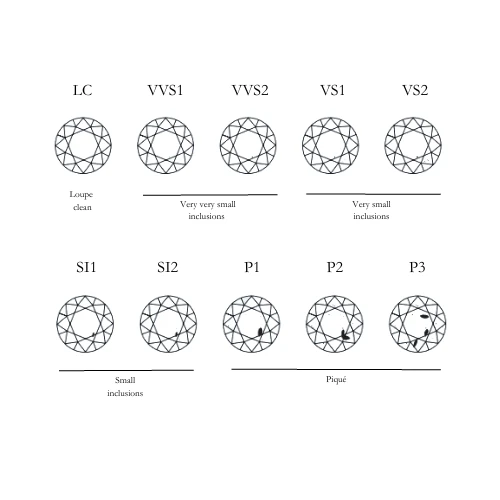In the vast realm of jewelry, diamonds have been captivating hearts for centuries. Their dazzling brilliance and rarity make them timeless symbols of love, luxury, and elegance. However, behind their resplendent shine lie subtle characteristics that determine their value and beauty. Thus begins the systematic exploration of the 4Cs: Carat, Color, Clarity, and Cut. These four criteria are the fundamental pillars that guide any enlightened jewelry enthusiast in their quest for the perfect diamond.
Whether you’re a seasoned connoisseur or an enthusiastic novice, this exploration of diamond selection criteria will sharpen your understanding in the heart of the most coveted gemstone universe. For each diamond, no matter how brilliant, holds a deep narrative, a story that comes to life when the 4Cs converge in an unmatched symphony.
Carat: Measurement of Weight

Carat is one of the most well-known and iconic characteristics of diamonds. It refers to the measurement of the gemstone’s weight, not its visible size to the naked eye. One carat equals 0.2 grams, approximately the weight of a small feather. The value of a diamond generally increases with carat weight, as larger diamonds are rarer. However, it’s not simply about opting for a high-carat diamond to ensure a sparkling stone. It’s essential to find a balance among the 4Cs to obtain the diamond that best matches your preferences and budget. This enchanting relationship between the weight and diameter of round brilliant-cut diamonds is unveiled through a graphical representation, thus captivating attention and encouraging exploration into the mysteries of their size and sparkle.
Color: Subtleties Influencing Appearance

Color is a decisive factor in evaluating and valuing a diamond. Contrary to what one might think, a less pronounced color is preferable in the context of diamonds. Diamonds are evaluated on an international scale that includes 23 nuances ranging from D to Z. However, only gemology experts can differentiate colors from one letter to another. This is why diamonds are grouped by color family: Colorless (D-E-F), Near colorless (G-H-I-J), Faint yellow (K-L-M), Very light yellow (N-O-P-Q-R), and Light yellow (S-T-U-V-W-X-Y-Z).
Additionally, diamonds are available in “fancy colors,” ranging from brown to vibrant yellow, passing through striking shades such as pink, purple, red, blue, and green. Furthermore, a fluorescence classification scale exists, as some diamonds react to ultraviolet light, with levels ranging from none to strong.
Clarity: Window into Inner Purity

Clarity is an essential element that determines the internal purity of a diamond. Due to their natural origin, each diamond contains internal and external imperfections known as inclusions and surface defects. Evaluated meticulously under a 10x magnifying loupe, clarity is based on the visibility, size, number, and arrangement of these imperfections. Clarity significantly influences a diamond’s appearance. Diamonds with higher clarity appear brighter and more transparent, allowing light to travel with remarkable ease.
Cut: Artisanal Mastery Sculpting Light

A diamond can take on various shapes to enhance its brilliance and make the most of the raw diamond extracted from the mine. However, the quality of the cut determines how light is reflected, refracted, and dispersed through the stone, creating its sparkle. Among the four diamond evaluation criteria, cut is the only one influenced by human expertise. Indeed, an improper cut can lead to excessive loss of raw material, or the diamond may appear dull and less luminous. Cut is not just about the diamond’s external shape, such as round, princess, emerald, etc. It also encompasses more technical aspects like proportions, symmetry, and polish.
• Proportion: The proportion grade evaluates how the diamond’s angles and dimensions are harmoniously balanced to maximize brilliance and light dispersion. Properly proportioned cut allows light to enter the diamond, reflect inside, and come out with dazzling sparkle. Incorrect proportions can lead to light escaping through the bottom or sides of the diamond, resulting in reduced brilliance.
• Symmetry: The symmetry grade examines the precision and regularity of the diamond’s facets as well as the alignment of its parts. High-quality symmetry ensures that facets meet harmoniously, creating a pleasing visual symmetry and uniform brilliance. Poor symmetry can lead to areas of shadow, affecting light reflection.
• Polish: The polish grade evaluates the quality of the diamond’s surface. High-quality polish is essential for optimal sparkle. If the diamond’s surface has scratches, blemishes, or defects, light can be diffused or blocked, reducing brilliance. Exceptionally smooth polish allows light to move unimpeded through the stone, creating magnificent sparkle.
Diving into the fascinating universe of the 4Cs, we discover that each diamond is much more than a mere gemstone. It’s a journey through infinite details, hidden subtleties, and artisanal expertise that transforms a raw gem into a sparkling work of art. When Carat, Color, Clarity, and Cut harmoniously converge, they create a magical balance where light dances, reflects, and bursts into a symphony of sparkle. The inclusions that bear witness to the stone’s history, the precision of the cut that sculpts light, the hue of color that adds a personal touch—these are all elements that blend to form unique diamonds, each with its own character. Whenever you admire a diamond, remember that each one carries the brilliance of an ancient heritage and the promise of a luminous future.

